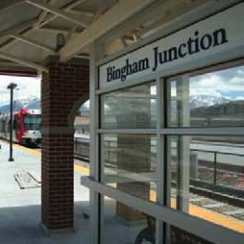Bingham Junction Case Study
Challenge
Superfund site doesn’t exactly sound like welcome home, but one Utah city is changing that. The
Bingham Junction development in Midvale sits on a slag pile. What once was a smelter is now a shelter for many families. “It’s a wonderful thing,” says Ray Limb, Midvale City, Superfund site coordinator. “We have apartments, town homes, condos, twin homes, light industrial, retail stores and businesses. We have a lot going on.”
The same wasn’t true a decade ago. The aftermath of smelters: slag, wastewater and dry cleaning
chemicals, existed on the site. Heavy metals such as lead and arsenic left a potentially toxic land mine
on the east banks of the Jordan River where not even spiders wanted to crawl. “That property sat
vacant for years,” says Chris Wright, Baseline regional sales manager. “It’s neat to see an area that was
deemed contaminated be developed with nice, high-end, multi-family and commercial properties.”

“The Baseline system is extremely valuable. If it didn’t work, we wouldn’t use it.”
-Ray Limb, Superfund Site Coordinator,
Midvale City
Solution
Clean up started in 2005. Put simply, the waste wasn’t moved off site. It was redistributed and covered with clean soil. The site was removed from the National Priorities List in 2006, development started in 2008 and now the EPA has a new poster child. “We are the EPA’s first site in United States that has been done this way,” Limb says. “We are a poster site and I’m the only full-time site development coordinator in the country through an EPA grant.”
Keeping all of the contamination under a clean cap requires precise control over water flow. That’s where Baseline comes in. “The site is unique in that it is developing on top of contamination,” Wright says. “It raised flags for developers, but raised an opportunity for Baseline. Baseline technology monitors the amount of moisture in the ground and there are limits. At a certain level, the system shuts off and won’t allow irrigation until the soil dries out.”
Sensors on the property are buried at two different depths. The system shuts off if too much moisture is collected at either depth. “The Baseline system is extremely valuable,” Limb says. “If it didn’t work, we wouldn’t use it. It’s an expensive system, but it saves us a lot in the long run. We’re protecting the requirements of keeping increased contamination out of the river.”
The risk to the river, and anyone on the development, would put some site managers in a constant state of worry, but Limb wears the weight of responsibility with confidence. “It doesn’t make me nervous because it works and anyway I’m too old to be nervous,” Limb says. “I just make sure everyone and everything works as it should. It’s when you let things slide that you have to worry.”
It takes diligence to get a Superfund site to the usable stage and now the poster child of possibility is proving you can do something great with a lot of nothing good in the ground. “We know there are a lot of contaminated, polluted sites undeveloped in the West,” Wright says. “This provides an alternative to architects and developers that’s more cost effective and environmentally friendly. There is significant potential here.”

